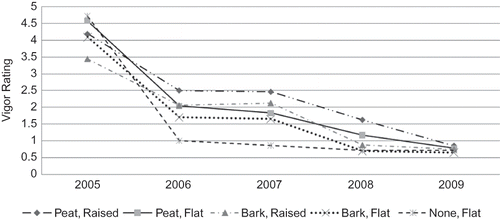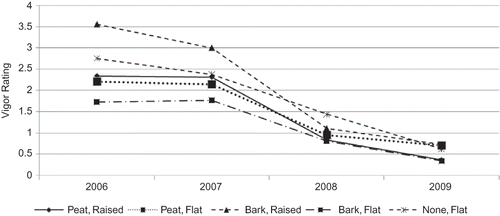Abstract
Phytophthora root rot is an important disease of commercial blueberries and is most severe when blueberries are grown in wet soils with poor drainage. Symptoms include small, yellow or red leaves, lack of new growth, root necrosis, and a smaller root system than healthy plants. Four studies were conducted in south Mississippi to evaluate the effect of bed height and soil amendment on the survival of 19 southern highbush blueberry cultivars transplanted into fields infested with the root rot pathogen, Phytophthora cinnamomi. Plants were rated twice a year for overall vigor on a scale of 0 = plant dead to 5 = most vigorous. The most vigorous cultivars were: ‘Southmoon’ in the 2005 study, ‘Gulfcoast’ in the 2006 study, and ‘Springhigh’ in the 2008 study. In the 2005 and 2006 studies, plants grown on raised beds were more vigorous than those grown on flat beds and those grown in soils amended with peat moss were more vigorous than those grown in soils with no amendment. In the 2008 study, plants grown in soil amended with pine bark were more vigorous than those grown in soil amended with peat moss. However, plant vigor declined each year, and most plants died within 3 years of planting whether they were planted on raised or flat beds and whether they received any soil amendments or not. No cultivar thrived in any planting. These studies demonstrate that southern highbush blueberries should not be planted in soils known to be infested with P. cinnamomi.
INTRODUCTION
Phytophthora root rot, caused by Phytophthora cinnamomi Rands, is a serious disease of highbush blueberry (Vaccinium corymbosum L.), but rabbiteye blueberry (V. ashei Reade) cultivars commonly grown in the southeastern U.S. are less susceptible. Southern highbush cultivars (hybrids between V. corymbosum and various blueberry species native to the southeastern U.S.) are being planted on an increasing acreage due to their early fruit production and reduced chilling requirement; however, as the acreage of blueberries increases, the potential threat of losses due to Phytophthora root rot also increases (CitationLyrene and Crocker, 1991).
Phytophthora root rot is most severe when blueberries are grown in wet soils with poor drainage. The initial infection of the roots may occur in nursery beds, in container yards when pots are set on poorly drained areas, and in fields infested with the pathogen. The causal fungus is spread by the movement of soil and water, and abundant soil moisture favors infection (CitationMilholland, 1995). Phytophthora cinnamomi attacks the small feeder roots, and infection may occur within 24 hr on highly susceptible cultivars (CitationMilholland, 1975). Symptoms of Phytophthora root rot are small, yellow or red leaves, lack of new growth, root necrosis, and a smaller root system than that of healthy plants. Infected plants generally have fewer and poorer quality fruit than non-infected plants and often die in a few years.
The recommended control for Phytophthora root rot of blueberries is based on cultural practices (CitationMilholland, 1995; CitationPscheidt, 2009). Plantings should be established with disease-free plants on soils with good aeration and drainage. Planting into raised beds and sub-soiling beside the row are recommended to improve drainage. Fields should not be over irrigated, but the soil should be saturated at each application and then allowed to dry between irrigations. Over-fertilization with nitrogen should be avoided. Phytophthora root rot has been a problem for southern highbush cultivars grown in pine bark beds, since these beds are often saturated with water through either irrigation or rainfall (CitationKrewer et al., 2010).
In south Mississippi, older rabbiteye blueberry plantings are being removed due to various reasons (CitationMiller-Butler et al., 2009) including decline due to Phytophthora root rot. Growers have indicated a desire to replant some of these fields with southern highbush cultivars; however, previous studies indicated that southern highbush cultivars, in general, are more susceptible to Phytophthora root rot than rabbiteye cultivars (CitationSmith, 2002, 2006, Citation2008). Four studies were initiated to compare the Phytophthora root rot susceptibility of 19 southern highbush cultivars grown in P. cinnamomi infested soil. The effect of two commonly recommended Phytophthora root rot control practices was also evaluated: raised beds versus flat beds and peat moss and bark soil amendments versus no amendment.
MATERIALS AND METHODS
One to 3 years before the initiation of each study, rabbiteye blueberry cultivars were removed from fields where they had been grown for 14 or more years. Plants in these fields exhibited typical root rot symptoms and many had died from root rot. Plants and large root debris were removed, and the soil was prepared by tilling and sub-soiling. New rows were prepared in the middle of where the old rows had been. Each spring from 2005 to 2008, 1-year-old potted plants of southern highbush cultivars were transplanted in single plant plots in these rows in a split block design with the whole plots being bed height, and the split plots being the soil amendment treatment. Two studies were established in 2005: one with eight cultivars and another with five cultivars. The 2006 study included 10 cultivars, the 2007 study had 2 cultivars, and the 2008 study had 12 cultivars. Bed height was either flat or raised beds (0.3 m high × 0.7 m wide). The soil amendments were: (1) no amendment, (2) peat moss applied at the rate of 8.5 liters/plants, and (3) bark applied at the rate of 8.5 liters/plants. Plants were spaced 1.3 m apart and grown consistent with standard commercial practices for blueberries in the southeastern U.S. (CitationBraswell and Spiers, 2003). Irrigation was applied as needed via drip tape. All plants in the 2008 study were established on raised beds. Each treatment was replicated three to five times in each study.
Plants were scored for vigor on a 0 = dead to 5 = most vigorous scale. The number of surviving plants, plant height, and plant width were determined each year in April and August. Plant size was calculated as volume using the height and width measurements. To confirm the presence of Phytophthora spp., roots were collected periodically from symptomatic plants, surface sterilized, and plated on Tsao and Guys's PVPH + hymexozol medium selective for Phytophthora spp. (CitationTsao, 1983). Fungal growth on the selective medium was typical of Phytophthora spp. One hundred ml of soil from each field was placed in 200 ml of sterile distilled water in a shallow dish. Eight small squares (3 mm2) of camilea leaves were floated on the surface of the water. After 3 days incubation at room temperature (∼25°C) infected leaf pieces were placed on PARPH V8 media (CitationFerguson and Jeffers, 1999). Isolates typical of Phytophthora spp. were recovered, transferred to fresh PARPH V8 media, and confirmed as P. cinnamomi by polymerase chain reaction (PCR) using the LPV2 and LPV3 genes (CitationKong et al., 2003).
Analyses of variance were used to determine the effects of treatments on plant vigor, height, size, and the percentage of living plants. Means were separated by Fisher's protected least significant difference test (SAS System, version 8.2; SAS Institute, Inc., Cary, NC, USA).
RESULTS AND DISCUSSION
2005 Study 1
In February 2005, eight cultivars were planted on raised or flat beds in soils with no amendment or amended with either peat moss or bark. In August 2005, ‘Star’, ‘Misty’, ‘Jubilee’, and ‘Biloxi’ had the highest vigor scores and the lowest percentage of dead plants while ‘Ozark Blue’, ‘Southmoon’, and ‘Sharpblue’ had the lowest vigor scores and the most dead plants (). There were no differences in vigor scores due to bed height or soil amendment. These plants were evaluated shortly before Hurricane Katrina caused severe damage to southern Mississippi. As a result of physical storm damage and lack of irrigation for two months following the storm, this study was discontinued.
TABLE 1 2005 Study 1: Vigor Score, Number, and Percentage of Plants Dead on August 16, 2005 of Eight Southern Highbush Cultivars Transplanted in February 2005
2005 Study 2
This study included five cultivars and at the end of the first summer, ‘Star’ received higher vigor scores than ‘Sharpblue’ (). At the end of the second and third summers, ‘Southmoon’ and ‘Star’ received higher vigor scores than ‘Jubilee’. More than 60% of the ‘Star’ and ‘Southmoon’ plants were alive at the end of the second summer, while less than 30% of the ‘Jubilee’ and ‘Misty’ plants were alive (data not shown). By the end of the third summer, approximately 50% of the ‘Star’ and ‘Southmoon’ plants were alive, while only 13% of the ‘Sharpblue’ plants, 10% of the ‘Misty’ plants, and none of the ‘Jubilee’ plants were alive. By August 2009, most plants in the study were dead or dying. Across all five cultivars, plants grown on raised beds had more surviving plants (69%), a higher plant vigor score (2.3) (), and were taller (50 cm) in April 2007 than those grown on flat beds (surviving plants = 45%, vigor = 1.6, height = 39 cm). There was not a significant effect due to soil amendment or a significant interaction between bed height and soil amendment () on any of the parameters measured.
FIGURE 1 Plant vigor ratings of five southern highbush blueberry cultivars established in a field infested with Phytophthora cinnamomi in south Mississippi in 2005. LSD (P = 0.05). 2005 = 0.91, 2006 = 1.28, 2007 = 1.21, 2008 = 1.10, 2009 = 1.10.

FIGURE 2 Average effect of bed height and soil amendment on plant vigor ratings of five southern highbush cultivars established in a field infested with Phytophthora cinnamomi in south Mississippi in 2005. LSD (P = 0.05). Bed height: 2005 = 0.6, 2006 = 0.7, 2007 = 0.7, 2008 = 0.6, 2009 = 0.6; Soil amendment: 2005 = 0.9, 2006 = 1.2, 2007 = 1.1, 2008 = 1.1, 2009 = 1.0.
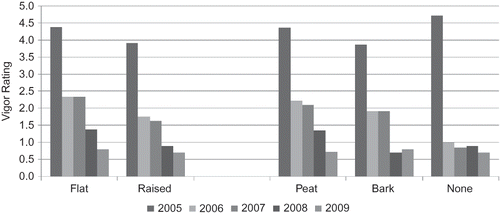
2006 Study
Of the ten cultivars included in this study, ‘Gulfcoast’ was the most vigorous at each evaluation (). In August 2006, it was significantly more vigorous than ‘O'Neal’, ‘Jewel’, and ‘Elliott’; in 2007 it was significantly more vigorous than all the other cultivars, and by 2009 it had the highest vigor rating (1.8) and the most living plants (22%) (data not shown). The majority of plants of other cultivars had died by the 2009 evaluation. In 2006 and 2007, the plants growing on raised beds were more vigorous than those on flat beds, but in 2008 and 2009 there were no differences in plant vigor due to bed height (). There were no differences due to soil amendment in any year. In 2006, there was a significant interaction between bed height and soil amendment: plants established on raised beds amended with ground bark were significantly more vigorous than those in the other treatment combinations ().
FIGURE 4 Plant vigor ratings of ten southern highbush cultivars established in a field infested with Phytophthora cinnamomi in south Mississippi in 2006. LSD (P = 0.05). 2006 = 1.19, 2007 = 1.16, 2008 = 1.10, 2009 = 1.00.

FIGURE 5 Average effect of bed height and soil amendment on plant vigor ratings of ten southern highbush cultivars established in a field infested with Phytophthora cinnamomi in south Mississippi in 2006. LSD (P = 0.05). Bed height: 2006 = 0.4, 2007 = 0.4, 2008 = 0.4, 2009 = 0.3; Soil amendment: 2006 = 0.8, 2007 = 0.7, 2008 = 0.7, 2009 = 0.6.
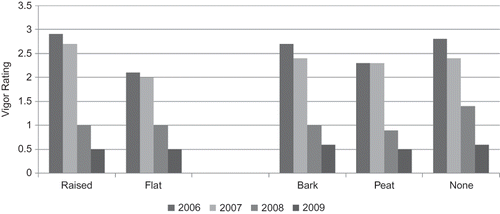
2007 Study
There were no significant differences in plant vigor due to bed height, soil amendment, or cultivar (). There was not a significant interaction between bed height and soil amendment.
FIGURE 7 Effect of bed height and soil amendment on plant vigor ratings of two southern highbush cultivars established in a field infested with Phytophthora cinnamomi in south Mississippi in 2007. LSD (P = 0.05). Bed height: 2008 = 0.64, 2009 = 0.57; Soil amendment: 2008 = 0.95, 2009 = 0.85; Cultivar: 2008 = 0.79, 2009 = 0.70.
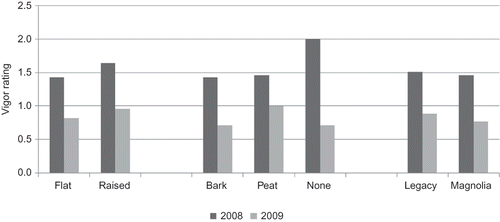
2008 Study
Among the 12 southern highbush cultivars established in a field with a history of Phytophthora root rot, after 1 year, the vigor scores of ‘Springhigh’, ‘Bluecrisp’, ‘Emerald’, ‘Jewel’, ‘Sapphire’, and ‘Star’ were higher than those of ‘O'Neal’, ‘Misty’, and ‘Southmoon’ (). After 2 years, ‘Springhigh’, ‘Jewel’, ‘Bluecrisp’, ‘Emerald’, and ‘Star’ were rated more vigorous than ‘Biloxi’, ‘Southmoon’, ‘Southern Belle’, ‘Abundance’, and ‘Misty’. Plants growing in soil amended with bark were more vigorous (3.1) than those growing in soil amended with peat moss (2.1).
FIGURE 8 Effect of soil amendment on plant vigor ratings of 12 southern highbush cultivars established in a field infested with Phytophthora cinnamomi in south Mississippi in 2008. LSD (P = 0.05). Cultivar: 2009 = 1.27, 2010 = 1.66; Soil amendment: 2009 = 0.52, 2010 = 0.68.
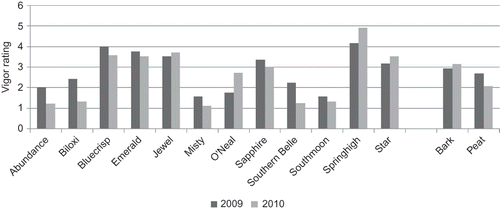
In a previous study conducted at Poplarville in a field near the ones used in the present studies (CitationSmith, 2002), root rot symptoms were evident on southern highbush and rabbiteye blueberry plants throughout the field after 2 years of growth in soil infested with Phytophthora spp., but there were no differences in disease severity or plant vigor due to bed height or fungicide treatment. After 5 years, only 21% of plants drenched with metalaxyl and 16% of plants grown on raised beds were very vigorous compared to 14% of plants grown in untreated soil and 9% of plants grown on flat beds. Previous studies, as well as this current study (CitationSmith, 2006, 2008), indicate that growers in the Gulf south should not plant blueberries in fields with a history of Phytophthora root rot. All southern highbush blueberry cultivars included in this and the previous studies have become infected with Phytophthora spp. and most have died in a few years when planted in soils with a history of root rot.
CONCLUSIONS
Cultural practices provide the best control for Phytophthora root rot of blueberries. Plantings should be established with disease-free plants on well-drained sites. Plants should be grown on raised beds and should not be over-irrigated or not over-fertilized. Fungicide treatments might slow the process of the disease on more resistant rabbiteye cultivars, but they will not cure an infection and have not been shown to slow symptom development on the more susceptible southern highbush cultivars. When southern highbush cultivars are grown in high density plantings in pine bark, rotation of the fungicides, mefenoxam and phosphate, is a good resistance-management practice; however, they will not correct problems caused by poor drainage. Growers should correct any drainage problems in a field before planting.
ACKNOWLEDGMENTS
I wish to thank Wanda S. Elliott and Melinda Miller-Butler for their technical assistance.
Notes
This article not subject to US copyright law.
Mention of a trademark, proprietary product, or vendor does not constitute a guarantee or warranty of the product by the U.S. Dept. of Agriculture and does not imply its approval to the exclusion of other products or vendors that also may be suitable
LITERATURE CITED
- Braswell , J.H. and Spiers , J.M. 2003 . “ Establishment and maintenance of blueberries ” . 12 Mississippi State University Extension Service Publication 1758 .
- Ferguson , A.J. and Jeffers , S.N. 1999 . Detecting multiple species of Phytophthora in container mixes from ornamental crop nurseries . Plant Dis. , 83 : 1129 – 1136 .
- Kong , P. , Hong , C.X. and Richardson , P.A. 2003 . Rapid detection of Phytophthora cinnamomi using PCR and primers derived from the LPV storage protein genes . Plant Path. , 52 : 681 – 693 .
- Krewer , G. , Brannen , P. , Cline , B. , Schnabel , G. , Hale , F. , Horton , D. , Burrack , H. , Czarnota , M. , Jennings , K. , Mitchem , W. , Monks , D. , Lockwood , D. , Bellinger , B. , Guillebeau , P. , Sumner , P. and Smith , P. 2010 . 2010 southeast regional blueberry integrated management guide , 59 Athens , GA : University of Georgia . Bulletin 48
- Lyrene , P.M. and Crocker , T.E. 1991 . “ Commercial blueberry production in Florida ” . In Fla. Coop. Ext. Ser. Handbook SP 179 , Gainesville , FL : University of Florida .
- Milholland , R.D. 1975 . Pathogenicity and histopathology of Phytophthora cinnamomi on highbush and rabbiteye blueberry . Phytopathology , 65 : 789 – 793 .
- Milholland , R.D. 1995 . “ Phytophthora root rot ” . In Compendium of blueberry and cranberry diseases , Edited by: Caruso , F.L. and Ramsdell , D.C. 7 – 8 . St. Paul , MN : APS Press .
- Miller-Butler , M. A. , Curry , K. J. , Smith , B. J. and Braswell , J. 2009 . Survey of blueberry (Vaccinium spp.) problems in the Gulf South . Acta Hort. , 810 : 369 – 378 .
- Pscheidt, J.W. 2009. Blueberry—Root rot. Online guide to plant disease control. Oregon State Univ. Extension. <http://plant-disease.ippc.orst.edu/disease.cfm (Record ID=186.00000)> (<http://plant-disease.ippc.orst.edu/disease.cfm (Record ID=186.00000)>) (Accessed: 26 June 2010 ).
- Smith , B.J. 2002 . Susceptibility of southern highbush blueberry cultivars to Phytophthora root rot . Acta Hort. , 574 : 75 – 79 .
- Smith , B.J. 2006 . Phytophthora root rot and Botryosphaeria stem blight: Important diseases of southern highbush blueberries in southern United States . Acta Hort. , 715 : 473 – 480 .
- Smith , B.J. 2008 . Cultural practices and chemical treatments affect Phytophthora root rot severity of blueberries grown in southern Mississippi . Intl. J. Fruit Sci. , 8 : 173 – 181 .
- Tsao , P. 1983 . “ Factors affecting isolation and quantitation of Phytophthora from soil ” . In Phytophthora: Its biology, taxonomy, ecology and pathology , Edited by: Erwin , D.C. , Bartnicki-Garcia , S. and Tsao , P.H. 219 – 236 . St. Paul , MN : APS Press .
